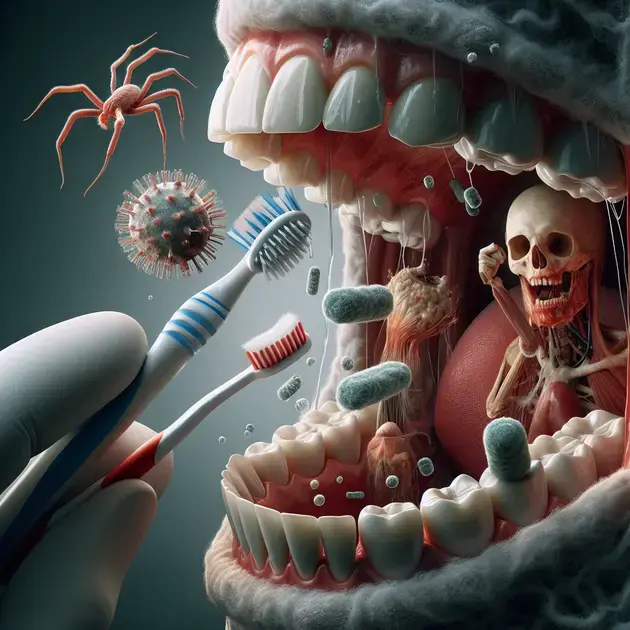Understanding Periodontal Diseases: What Should You Know?
Before your smile fades, arm yourself with important knowledge about periodontal diseases. Discover the causes, symptoms, and treatments that could save your teeth and preserve your oral health. Stay informed and take control of your dental hygiene with our comprehensive guide to periodontal diseases.

Understanding Gum Disease Causes and Risk Factors
Gum disease, also known as periodontal disease, is mainly caused by plaque buildup on teeth. Plaque is a sticky film of bacteria that forms on teeth and gums. Risk factors for gum disease include poor oral hygiene, smoking, hormonal changes, certain medications, diabetes, and genetic predisposition. To prevent gum disease, it is essential to maintain good oral hygiene habits such as brushing twice a day, flossing daily, and visiting your dentist regularly for check-ups and cleanings.
One helpful resource to learn more about gum disease causes and risk factors is the American Dental Association website. They provide comprehensive information on how plaque leads to gum disease and the various risk factors associated with this common oral health issue.
Additionally, utilizing a reliable dental app like MyTeeth can help track your oral hygiene habits and send reminders for brushing, flossing, and dental appointments. Such apps can be beneficial in preventing gum disease by promoting consistent oral care routines.
By understanding the causes and risk factors of gum disease, individuals can take proactive steps to maintain their oral health and prevent the development of periodontal issues.
Symptoms of Periodontal Diseases to Watch Out For
Common symptoms of periodontal diseases include red, swollen, or tender gums, bleeding while brushing or flossing, persistent bad breath, receding gums, and loose teeth. If left untreated, periodontal diseases can lead to tooth loss and other serious health complications. It is crucial to pay attention to these symptoms and seek prompt dental care if you notice any warning signs of gum disease.
For detailed information on the symptoms of periodontal diseases, individuals can visit reputable websites like Mayo Clinic. Mayo Clinic offers in-depth explanations of gum disease symptoms and the potential consequences of untreated periodontal issues.
In addition to online resources, using a symptom checker app like WebMD can help individuals assess their oral health and determine if they are experiencing any signs of periodontal diseases. These tools can assist in early detection and intervention for better treatment outcomes.
Regular dental check-ups and consultations with your dentist can also help identify and address any developing periodontal problems before they progress into more severe conditions.
Preventing and Treating Periodontal Diseases
Preventing periodontal diseases involves maintaining good oral hygiene practices, eating a balanced diet, avoiding tobacco products, and attending regular dental check-ups. Brushing with a fluoride toothpaste, flossing daily, and using an antimicrobial mouthwash can help reduce the risk of gum disease. Additionally, consuming a diet rich in fruits, vegetables, and lean proteins supports overall oral health.
To explore effective preventive measures and treatment options for periodontal diseases, individuals can refer to the Centers for Disease Control and Prevention (CDC) website. The CDC offers valuable insights into preventing gum disease and managing its progression through lifestyle changes and professional dental care.
Incorporating a habit-tracking app like Habitica into your routine can assist in building and maintaining oral care habits that contribute to preventing periodontal diseases. Such apps gamify habit formation and can make oral hygiene routines more engaging and rewarding.
By following preventive strategies and seeking timely treatment from dental professionals, individuals can reduce the risk of periodontal diseases and safeguard their oral health for the long term.

**Recognizing Early Signs of Periodontal Diseases**
Signs to Watch Out For
When it comes to identifying early signs of periodontal diseases, it is essential to be vigilant about any changes in your oral health. One common early indication is bleeding gums, especially when brushing or flossing. Additionally, persistent bad breath that is not alleviated by regular oral hygiene practices can also be a red flag for periodontal issues. Another sign to watch out for is gum recession, where the gums start to pull away from the teeth, creating pockets that can harbor bacteria and lead to further complications.
Furthermore, noticing loose or shifting teeth, changes in your bite, or the development of deep pockets between your teeth and gums are all potential signs of periodontal diseases. It is crucial to pay attention to these symptoms and seek professional dental care if you notice any of them to prevent the disease from progressing.
Early Intervention and Treatment
Early detection of periodontal diseases is key to effective treatment and management. If you suspect that you may have symptoms of gum disease, scheduling a comprehensive dental examination is essential. A dentist can evaluate the health of your gums, perform a deep cleaning to remove plaque and tartar buildup, and recommend appropriate treatment options.
Treatment for periodontal diseases may include scaling and root planing to remove bacteria from the tooth surfaces and smooth out the roots to help the gums reattach properly. In some cases, antibiotics or surgical interventions may be necessary to address advanced stages of the disease. By addressing the issue early on, you can prevent further damage to your gums and teeth and maintain optimal oral health.
**Effective Home Care Practices for Periodontal Health**
Establishing a Daily Oral Hygiene Routine
Maintaining good oral hygiene habits is crucial for preventing and managing periodontal diseases. Brushing your teeth twice a day with a fluoridated toothpaste and flossing regularly can help remove plaque and bacteria that contribute to gum disease. Using an antimicrobial mouthwash can also aid in reducing bacteria and promoting gum health.
Additionally, incorporating interdental cleaning tools such as dental picks or water flossers into your daily routine can help clean hard-to-reach areas between the teeth and along the gumline. By establishing a consistent oral hygiene regimen, you can reduce the risk of developing periodontal diseases and maintain a healthy smile.
Healthy Diet and Lifestyle Choices
What you eat and drink can have a significant impact on your oral health. Consuming a balanced diet rich in fruits, vegetables, and lean proteins can provide essential nutrients that support gum health. Limiting sugary and acidic foods and beverages can help prevent the buildup of plaque and protect your teeth from decay. Staying hydrated by drinking plenty of water throughout the day can also help flush out bacteria and maintain saliva production, which aids in protecting your teeth and gums.
Furthermore, avoiding tobacco products and reducing alcohol consumption can lower your risk of developing gum disease and other oral health issues. Making healthy lifestyle choices can complement your oral hygiene efforts and contribute to overall wellness.
**The Role of Professional Dental Cleanings in Preventing Periodontal Diseases**
Importance of Regular Dental Visits
Scheduling routine dental cleanings and exams is essential for preventing periodontal diseases and maintaining optimal oral health. During a professional cleaning, a dental hygienist will remove plaque and tartar buildup from your teeth and gums, reducing the risk of gum inflammation and infection. Additionally, your dentist will perform a thorough examination to assess the health of your gums, teeth, and jaw, allowing for early detection of any potential issues.
Professional dental cleanings also provide an opportunity for personalized oral hygiene education and recommendations tailored to your specific needs. Your dental care team can advise you on effective home care practices, dietary choices, and lifestyle habits that can help prevent periodontal diseases and support your overall oral health.
**
Conclusion
**
In the realm of oral health, recognizing the early signs of periodontal diseases is paramount for maintaining a healthy smile. From bleeding gums to persistent bad breath and gum recession, being vigilant about these symptoms can lead to timely intervention and treatment. By addressing issues like loose teeth, changes in bite, and deepening gum pockets promptly, individuals can prevent the progression of periodontal diseases and safeguard their oral well-being.
Early intervention through comprehensive dental examinations, deep cleanings, and potential treatments like scaling and root planing is crucial for managing gum diseases effectively. By seeking professional dental care when symptoms arise, individuals can curb the advancement of the disease and preserve their gum and teeth health for the long term.
Establishing a robust daily oral hygiene routine, incorporating interdental cleaning tools, and following a balanced diet rich in essential nutrients are vital steps in preventing periodontal diseases. Coupled with avoiding tobacco products, moderating alcohol consumption, and staying hydrated, these practices contribute to overall oral health and well-being.
Regular dental visits for professional cleanings and exams play a pivotal role in preventing periodontal diseases. These appointments not only remove plaque and tartar buildup but also offer personalized education on oral hygiene practices tailored to individual needs. By staying proactive with dental care, individuals can reduce the risk of gum disease and promote optimal oral health.
Understanding the causes, risk factors, symptoms, and preventive measures surrounding gum diseases empowers individuals to take charge of their oral health. Utilizing reliable resources like the American Dental Association, Mayo Clinic, CDC, and habit-tracking apps enhances awareness and supports consistent oral care routines. By combining knowledge, proactive measures, and professional guidance, individuals can navigate the landscape of periodontal diseases with confidence and ensure lasting oral health benefits.